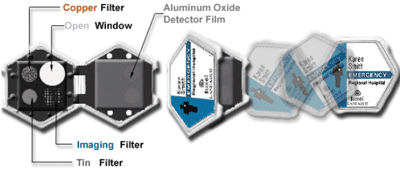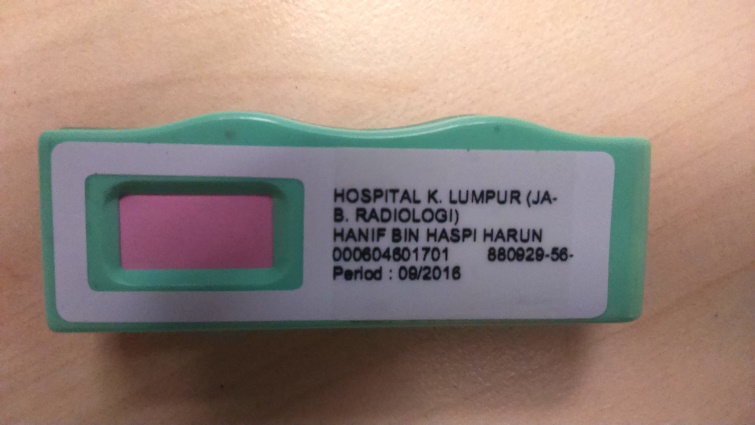Introduction
Personal Dosimeter has been used in various field that deals with ionizing radiation. It is one of requirement for personal that working with ionizing radiation for personal radiation monitoring. Nowadays variety of personal dosimeter that promising high detection sensitivity to get high accuracy of personal dose. Personal dosimeter can be divided into two categories which is Active Dosimeter and Passive Dosimeter. Active Dosimeter Optical Stimulated Luminescence Dosimeter (OSL), Radio photo luminescence Dosimeter (RPL) and Thermo luminescence Dosimeter (TLD) are various type of passive dosimeter has been used that have different type of luminescence material used, principle of measurement, excitation source and others.
Type of dosimeters
Optical Stimulated Luminescence Dosimeter (OSL) and Thermo luminescence Dosimeter (TLD) are two type of personal dosimeter that have similarity luminescence material that be used which is a crystal. OSL has developed by using plastic disks filled aluminium oxide doped with carbon (Al2O3: C) as a detector material. Light-tight plastic holder has been used to cover the plastic disk. Crystal of (Al2O3: C) either contains or have added trace amounts of contaminants that form crystal-lattice imperfections. These imperfections cause the electrons or holes will be trapped and become luminescence centres as well. Luminescence centres act as position where electron and hole recombine and produce emitting or luminescence light. This principle description of OSL and TLD are matching each other but the different between them is for OSL the crystal lattice is use optically stimulated to emit luminescence light while TLD is using heat.

Figure 1: Optical Stimulated Luminescence Dosimeter (OSL)
Detail process
In detail process of OSL and TLD when ionizing radiation enter these both personal dosimeter it generated free electrons and holes pair that can be trapped inside the crystal lattice. Conduction band is filled with electron while holes are been in valance band. The excited electrons in conduction band trapped in the electron or hole trap. Under stimulation of visible light for OSL and heat for TLD the electrons will be excited again from the trap and get into the conduction band. Electron will recombine from the conduction band with holes in hole trap. Emission of light produce when the centre of the hole is a luminescence centres which is radiating recombination centre. The emission of luminescence light is detected using a photomultiplier tube. The signal from the tube is then used to calculate the dose that the material had absorbed. The emission of light signal produces is proportional to the ionizing radiation absorb by the material in personal dosimeter. Like TLD the “glow curve” produced by this process is then related to the radiation exposure.

Figure 2: Thermo luminescence Dosimeter (TLD)
Unlike TLD and OSL, RPL definitely has different principle and measurement technique where RPL used different luminescence material and excitation source. RPL is used glass compound instead of crystal as luminescence material. Old type of glass compound contains of 25% of KPO3, 25% of Ba (PO3)2 and 50% of Al (PO3)2, with proper amount of AgPO3 to form silver activated phosphate glass. Technology are developed to increase the sensitivity of the luminescence material by controlling the composition of element in glass compound. Thus for latest technology of RPL we can measured the personal dose as low as 10 µGy instead of 1 mGy when RPL was first introduced.
The principle of RPL is that when glass compounds exposed to radiation the chemical characteristics of the silver ions cause formation a colour centres that structured at the silver activated phosphate glass. Colour centre is where the electron that excited from radiation exposure is being trapped. The trapped electron needs to stimulate with pulse ultraviolet light (usually 337.1 nm) and excited again to the higher energy level with emission of 600 – 700 nm visible orange light, then return to the original colour centres. Visible orange light are emitted is an indicator of the intensity of the radiation. This process is called radio-photoluminescence phenomena. RPL is able to re-readout again for same irradiation due to electrons in colour centres return to the electron traps after emitting the radio-photoluminescence with same intensity compare with OSL which is the intensity reduce for repeatable readout. Same with TLD and OSL the emission of radio-photoluminescence are detected using a photomultiplier tube. The signal from the tube is change from analogue to digital for dose calculation.

Figure 3: Radio photoluminescence Dosimeter (RPL)
It shows that technique used to measure the intensity of radiation received for RPL varies to compare to TLD and OSL. RPL is made from inorganic amorphous solid whereby lattice structure and lattice luminescence centres are not exist inside amorphous compound. Thus difficulty to get the information on electron trip(s) distribution functions to establish the luminescence model was an issue. To overcome this we only establish the radio-photoluminescence model based on the energy gap between energy level at colour centre and excited energy level which electrons jump. The energy of the released radio-photoluminescence is also other way to establish that model due to proportional to the intensity of the radiation is being absorbed. Meanwhile, crystal material inside TLD and OSL have an order structure with lattice defects thus the information on the electron distribution functions at different energy trap(s) can be provided.
Conclusion
RPL promising the best dose measurement devices compare to TLD and OSL with some reasons. The main reason is the luminescence signal does not have losses after readout therefore, repeated readout for a single exposure is possible for RPL. For management purpose if re-calculation of personal radiation dose is requiring RPL is the best device to ensure it. Moreover RPL is suitable for variety of medical field deal from lower ionizing radiation such as Diagnostic Radiology to even higher ionizing radiation such as IMRT (Intensity Modulated Radiotherapy) due to wide measurable dose range (0 – 500 Gy). No correction factor needed is one of advantages using RPL compare both TLD and OSL. The luminescence signal can be converted to the exposure dose directly without considering about the correction factors. Readout system of RPL provides reference readout to measure the exposure dose.
References
- Jursinic, Paul A. 2007. “Characterization of Optically Stimulated Luminescent Dosimeters, OSLDs, for Clinical Dosimetric Measurements.” Medical Physics Phys. Med. Phys. Med. Phys 3436(37): 1690–99.
- Europe, Landauer. “Medical Dosimetry Using Optically Stimulated Luminescence Dots and.” : 1–10.
- Huang, David Y C, and Shih-Ming Hsu. 2011. “Radio-Photoluminescence Glass Dosimeter (RPLGD).” Advances in Cancer Therapy: 568.
- NDT Resource Center. 2001. “Thermoluminescent Dosimeter.” NDT Education Resource Center: 2012. https://www.ndeed.org/EducationResources/CommunityCollege/RadiationSafety/radiation_safety_equipment/thermoluminescent.htm
- Cygler, Joanna E, and Eduardo Yukihara. “Optically P Y Stimulated Luminescence ( OSL ) Dosimetry in Radiotherapy Disclosure The Authors Have Received Research Support from Landauer Inc.” DisClosure.
| Last Reviewed | : | 17 March 2017 |
| Writer | : | Hanif bin Haspi Harun |
| Accreditor | : | Adzlin Hana bt. Mohd Sari |







